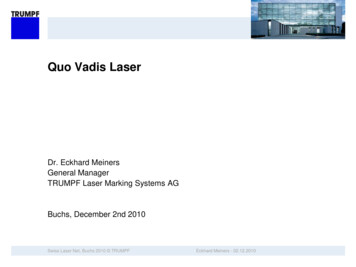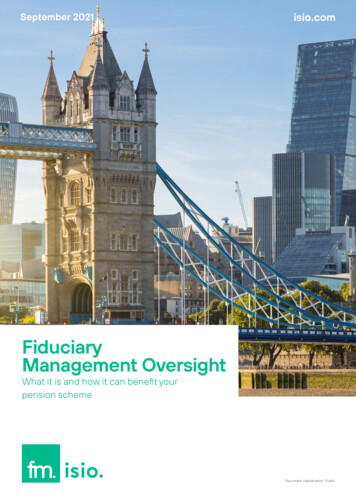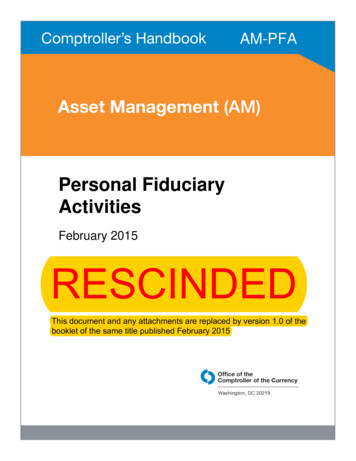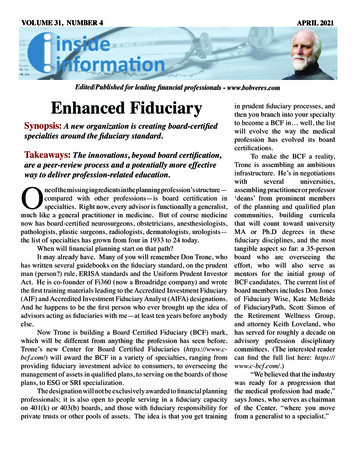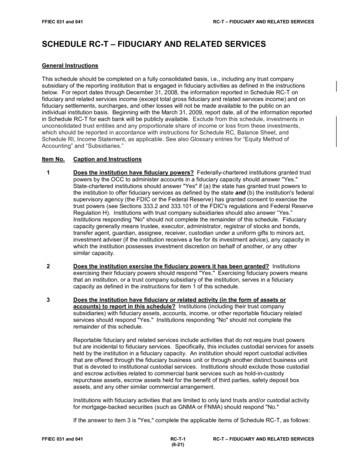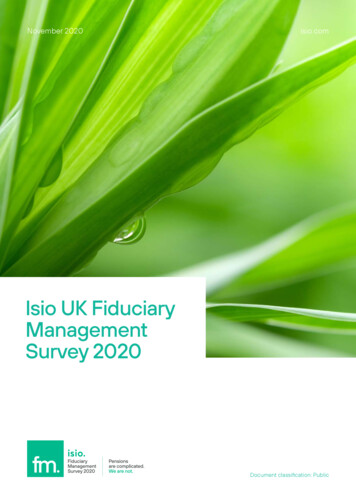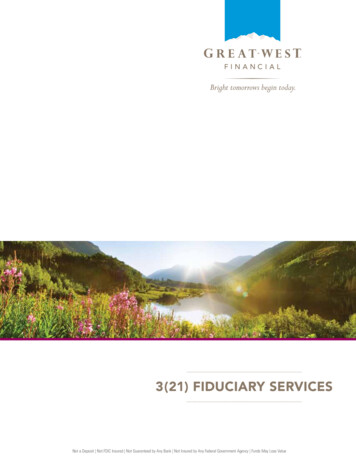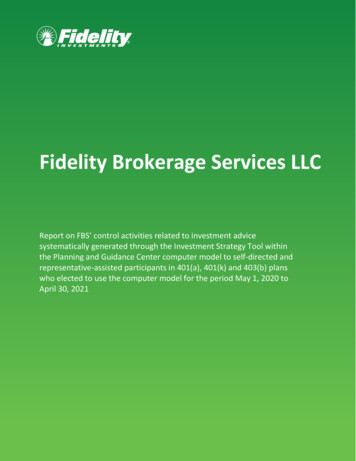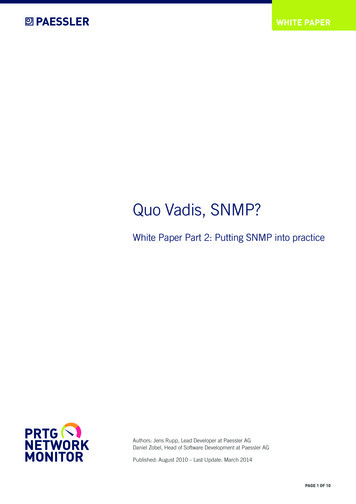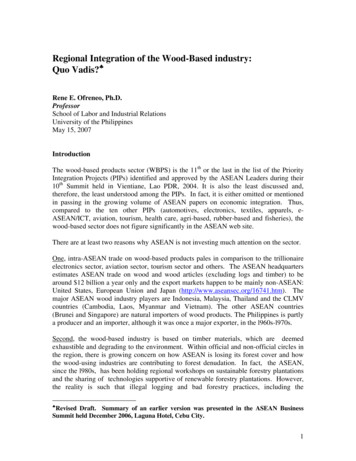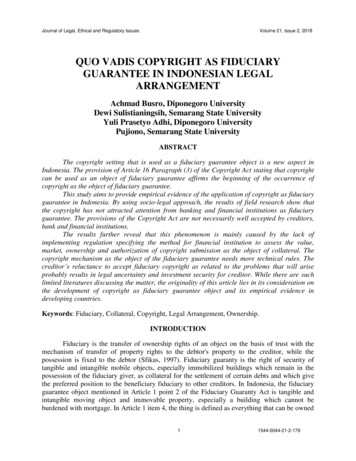
Transcription
Journal of Legal, Ethical and Regulatory IssuesVolume 21, Issue 2, 2018QUO VADIS COPYRIGHT AS FIDUCIARYGUARANTEE IN INDONESIAN LEGALARRANGEMENTAchmad Busro, Diponegoro UniversityDewi Sulistianingsih, Semarang State UniversityYuli Prasetyo Adhi, Diponegoro UniversityPujiono, Semarang State UniversityABSTRACTThe copyright setting that is used as a fiduciary guarantee object is a new aspect inIndonesia. The provision of Article 16 Paragraph (3) of the Copyright Act stating that copyrightcan be used as an object of fiduciary guarantee affirms the beginning of the occurrence ofcopyright as the object of fiduciary guarantee.This study aims to provide empirical evidence of the application of copyright as fiduciaryguarantee in Indonesia. By using socio-legal approach, the results of field research show thatthe copyright has not attracted attention from banking and financial institutions as fiduciaryguarantee. The provisions of the Copyright Act are not necessarily well accepted by creditors,bank and financial institutions.The results further reveal that this phenomenon is mainly caused by the lack ofimplementing regulation specifying the method for financial institution to assess the value,market, ownership and authorization of copyright submission as the object of collateral. Thecopyright mechanism as the object of the fiduciary guarantee needs more technical rules. Thecreditor’s reluctance to accept fiduciary copyright as related to the problems that will ariseprobably results in legal uncertainty and investment security for creditor. While there are suchlimited literatures discussing the matter, the originality of this article lies in its consideration onthe development of copyright as fiduciary guarantee object and its empirical evidence indeveloping countries.Keywords: Fiduciary, Collateral, Copyright, Legal Arrangement, Ownership.INTRODUCTIONFiduciary is the transfer of ownership rights of an object on the basis of trust with themechanism of transfer of property rights to the debtor's property to the creditor, while thepossession is fixed to the debtor (Sfikas, 1997). Fiduciary guaranty is the right of security oftangible and intangible mobile objects, especially immobilized buildings which remain in thepossession of the fiduciary giver, as collateral for the settlement of certain debts and which givethe preferred position to the beneficiary fiduciary to other creditors. In Indonesia, the fiduciaryguarantee object mentioned in Article 1 point 2 of the Fiduciary Guaranty Act is tangible andintangible moving object and immovable property, especially a building which cannot beburdened with mortgage. In Article 1 item 4, the thing is defined as everything that can be owned11544-0044-21-2-179
Journal of Legal, Ethical and Regulatory IssuesVolume 21, Issue 2, 2018and transferred, whether tangible or intangible, registered or unregistered, moving or immovablethat cannot be borne by mortgage or mortgage rights. Legally, the fiduciary guarantee object isset in Article 1 points 2 and 4, Article 2 and Article 3 of the Fiduciary Guaranty Act. Article 2 ofthe Act affirms that this Act applies to any agreement that aims to burden objects with fiduciaryguarantees and is then affirmed by Article 3 which states the Act is not applicable to: 1)mortgage rights related to land and buildings, as long as the applicable laws and regulationsdetermine such items shall be registered; 2) mortgages on registered vessels with gross content of20 (twenty) metres square or more; 3) mortgage on airplanes and 4) pawn.Based on the Decree of the Ministry of Law and Human Rights, the Directorate Generalof Legal Administration to the Regional Office of the Department of Law and Human Rights ofJakarta No C. HT. 06-10-01 dated February 24, 2010, it is stated that: (1) The object of fiduciaryguarantee is a material right; (2) The project terms, leases, contracts or borrowings and otherpersonal rights are not understood as objects of fiduciary security; (3) The insurance policy shallnot be subject to fiduciary security because of the insurance/insurance policy that is the inherentright of the person who owns it but is not transferable. In essence, the fiduciary guarantee is anobject which ownership rights may own and transfer, whether tangible or intangible, registeredor unregistered, mobile or immovable, which cannot be borne by mortgages. On the other hand,the object of fiduciary assurance, especially on intangible objects, has a significant development.Law No. 28 of 2014 on Copyright has governed the development of intangible objects that canbe guaranteed by fiduciary collateral. Copyright Law also regulates copyright as a fiduciarysecurity object. This is stated in Article 16 paragraph (3) of the Copyright Act stating ‘copyrightcan be used as an object of fiduciary guarantee.’Copyright arguably has prospects to serve as credit collateral, because it has an economicvalue and can be transferred either entirely or partially. The presence of Article16 paragraph (3)of the Copyright Law does not necessarily make the bank easily give its loan. The bank cannotaccept the copyright as the object of fiduciary guarantee because of the rules that support it. Thearrangement in Article 16 paragraph (3) does require further elaboration. This is related to theguarantee for the bank itself to get the certainty of the refund that has been lent. The copyrightedwork as the object of fiducially guarantee in Indonesia only exists after the enactment of LawNo. 28 of 2014, so the arrangement order is incomplete. Banking parties in Indonesia have notpracticed copyright as a credit guarantee because there are some obstacles in the implementation.These barriers relate to issues of value, market, ownership and authorization of copyrightsubmission as the object of collateral. These barriers arise because there is no special regulationon copyright as an object of guarantee, including the unavailability of an appraisal agency thathas the ability to provide an assessment of the economic value of a copyright. This situationposes a considerable risk to the banks to accept the copyright as an object of guarantee. Thefinancial institution of either bank or non-bank will undertake appraisal in advance of aguarantee object, such as the readiness of the creators, copyright holder and financial institutionand the proper mechanism for carrying out an assessment of the value of recorded or unrecordedcopyright.LITERATURE REVIEWHistorically, the term ‘transfer and security financial collateral arrangement’ wasimplemented in the Roman law (Mangatchev, 2008). Fiduciary or Fiduciary EigendomOverdracht/FEO is a transfer of ownership based on trust. The term ‘fiduciary’ means trust, in21544-0044-21-2-179
Journal of Legal, Ethical and Regulatory IssuesVolume 21, Issue 2, 2018which the parties give each other’s trust, i.e., one party gives full trust to other parties to transfertheir ownership, but the objects that are used as collateral is a guarantee of debt. Anotherdefinition of fiduciary is the transfer of ownership rights to the debtor's goods which are pledgedto the creditor on the basis of trust, whereas physically the goods concerned remain with thedebtor (Hadisoeprapto, 1984). Fiduciary is a transfer of ownership of objects in the control of theobject owner. Fiduciary guarantee is the right of guarantee for moving objects, both tangible andintangible, as well as immovable objects, especially buildings, that cannot be burdened with thebail and remain in the control of the debtor. This guarantee is functional as collateral for therepayment of a certain debt, which guarantees to the creditors toward other creditors (Adhi,2014).Based on the above definition of fiduciary, Article 1(1) of the Law No. 42 of 1999 onfiduciary guarantee states that ‘fiduciary is a transfer of ownership of an object on the basis oftrust with the condition that the transferred object remains in the control of the object's owner.’From the statement, there are some elements of fiduciary, including: (1) the transfer ofownership of an object; (2) is done on the basis of trust; and (3) the object remains in the hand ofits owner. Fiduciary is the transfer of ownership of an object on the basis of trust provided thatthe object to which the right of ownership is transferred shall remain in the possession of thepossessor of the object (Gold, 2007). Fiduciary guarantee is the right of assurance of tangible andintangible mobile objects, especially buildings which cannot be burdened with mortgageliabilities which remain in the control of fiduciary givers, as collateral for certain debtrepayment, which gives priority to fiduciary recipients over other creditors. Fiduciary inIndonesia has grown since 1931, contained in court decisions (arrest of HGH in BPM-Cligentcase). This means that fiduciary has been known in court decisions. Furthermore, fiduciarydevelopment has become more popular since fiduciary institutions meet the needs in practice.This is because fiduciary is very closely related to the credit agreement of the bank, when thedebtor wants to borrow money from the bank to expand its business by providing assurance ofmoving objects, because the debtor has no guarantee of other objects (Sutedi, 2012).In other countries such as in the United States, guarantees of intangible goods such ascopyright are set up. Software developers can get help from financial institutions. The provisionsin Article 16 paragraph (3) are related and even dependent on other laws, as mentioned in Article16 paragraph (4) that ‘the provisions concerning copyright as fiduciary security objects asreferred to in paragraph (3) are carried out in accordance with the laws and regulations.’ Theclosest legislation is Law no. 42 of 1999 on Fiduciary Guarantee. Copyright may be subject tofiduciary guarantees as set forth in the Copyright Act, not on objects that are encumbered withthe copyright, but on the economic value attached to the copyright (Sudjana, 2012). Subsequentdevelopments need to be examined more deeply by conducting research to determine thedevelopment of intangible objects assurance that can be guaranteed fiduciary. The object offiduciary assurance which develops due to the new provisions in the rule of the Act shall result inanother provision in the fiduciary guarantee that is related to the process of making fiduciaryassurance with the object of assurance of intangible objects. Possibilities may occur such ascopyright that may be the object of fiduciary collateral, that is, other rights in the intellectualproperty such as brand rights, patents, industrial design rights, etc.31544-0044-21-2-179
Journal of Legal, Ethical and Regulatory IssuesVolume 21, Issue 2, 2018METHODOLOGYResearch DesignThis study is a qualitative research that aims to discover the meanings behind subject ofresearch using secondary data as initial data continued by seeking the primary data (Budiharseno,2017; Nugroho, Bakar and Ali, 2017). This study used the socio legal approach, that containstwo aspects of research, namely (a) the legal aspects of research, namely the object of researchexisted in the form of law in the sense of norm, and (b) socio research, namely the use of socialscience theories and methods to help researchers conduct analysis (Zamroni, 1992).Data Collection and SamplingThe research was conducted at the Regional Office of the Ministry of Law and HumanRights of the Special Capital Region of Jakarta and the Provinces of Central Java, East Java,West Java, as well as the Ministry of Justice and Human Rights of the Republic of Indonesia andnotary firms. The selection of notaries as informants is determined purposively, while thenumber of informants is not determined by the limitative but follows the principle of a snowballsampling, in accordance with the need for informants in the reality research. Data in this researchconsist of primary data and secondary data. Primary data is data sourced from the partiesinvolved in the problem, as the object of research. In other words, data was obtained from fieldresearch (Muhammad, 2004), including key informants consisting of respondents from theMinistry of Law and Human Rights, notaries, Financial Services Authority of Indonesia(Otoritas Jasa Keuangan/OJK), National Legal Development Board (Badan Pembinaan HukumNasional/BPHN), Directorate General of Intellectual Property, Financial Institutions and otherinformants from practitioners and academics. The secondary data was sourced and obtainedthrough document and literature study on primary legal materials. The data in this research isobtained through observation activities, interviews (Coffey, 2004), visual sightings,interpretation of documents and materials, as well as personal experience. In accordance withthis research paradigm, in making observations, researchers will take a position as a participantobserver. Researcher is the key instrument (Nasution, 1992; Bogdan and Taylor, 1992) in datacollection. In-depth interviews were done with open ended questions, but it is possible to answerclosed-ended questions especially for informants who have a lot of information but there areobstacles in elaborating the information.Data AnalysisThe analysis of primary data was done using the technique adopted from Stratuss andCorbin (1990), i.e., by analysing the data since the researcher was in the field. The researchersused an interactive analysis using a field note consisting of description and data reflection(Sutopo, 1990). Furthermore, researchers conducted a data classification through the process ofindexing, sharing, grouping and filtering. After the research data was considered valid andreliable, the next step was to reconstruct and analyse it by inductive and qualitative methods toanswer the problems of the focus of research (Sudarto, 2002) using data analysis techniquesproposed by Miles and Huberman (1992) which consists of three cycles of activity, i.e., datareduction, data presentation and conclusion or verification.41544-0044-21-2-179
Journal of Legal, Ethical and Regulatory IssuesVolume 21, Issue 2, 2018RESULTSIntellectual Property Rights (IPR) is from the brain that produces a useful product orprocess to humans. In essence, the IPR is the right to enjoy the result of an intellectual creativity.IPR objects are works that arise or are born because of human intellectual abilities that arebroadly divided into 2 (two) major parts namely: 1. copyright and 2. industrial property rights,which include patent, industrial design, trademark, lay out design of the integrated circuit, tradesecret and varieties of plants protection. In Indonesia, the stipulations regarding the copyright asa fiduciary object is regulated in Article 16 paragraph (3) of Law No. 28 of 2014 and is also inaccordance with article 1 paragraph (2) of Law No. 42 of 1999 concerning fiduciary guarantee.The copyright under Article 16 paragraph (3) of Law No. 28 of 2014 is an intangible movingobject. It is legally well regulated in article 1, paragraph (2) of Law No. 42 of 1999, stating thatas the intangible moving object, copyright can be used as fiduciary. There, copyright is regardedas a moving object that is not tangible and having an economic value that can be used as anobject of guarantee. The copyrights that can be made into a fiduciary guarantee are copyrightsthat have been registered in the Directorate General of Intellectual Property. The development ofIPR as a fiduciary guarantee in terms of various aspects of existing law has a very significantcorrelation value.Under the existing legislation, the IPR must be transferable. This provision of "transfer ofrights" applies thoroughly to all areas of IPR, namely copyright, trademark, patent, industrialdesign, Integrated Circuit Layout Design (DTLST), trade secrets and plants variety protectionand other objects such as follows (a) inheritance, b) grants, (c) testaments, (d) writtenagreements, or (e) other reasons justified by laws and regulations. IPR can be guaranteed by afiduciary by transferring with a written agreement. This transfer is related to the economic valueof IPR. In doing so, copyright as an intangible moving object can be guaranteed as an object offiduciary guarantee. With this provision, the copyright that has been registered through theDirectorate of Intellectual Property, Ministry of Justice and Human Rights of the Republic ofIndonesia can be subsequently registered as a fiduciary guarantee whose object of guarantee isthe copyright. The characteristics of an object used as an object of debt guarantee is that is anobject that has an economic value in the sense of a time when a debtor cannot pay off its debtand the object can be used to pay that debt. In relation to copyright as the object of warranties, acopyright that can be used as a guaranteed object, of course, shall have an economic value andhave been registered with the Directorate General of Intellectual Property Rights and is still in aperiod of protection as it relates to the economic value the copyright. The most likely guaranteeinstitution to be imposed on copyright as an object of debt guarantee is a fiduciary guaranteeagency considering the type of the object of collateral in the form of moving objects andconcerning the delivery of collateral goods (Sudjana, 2012). In practice, in Indonesia, fiduciaryguarantees are mostly done with the object of assurance of tangible moving objects. Data fromthe Ministry of Law and Human Rights states that in 2016 the fiduciary registration on the objectof fiduciary assurance of tangible moving objects is 10,397,795, while the fiduciary guaranteeregistration data on intangible moving objects, as shown in Table 1, is much less.51544-0044-21-2-179
Journal of Legal, Ethical and Regulatory IssuesVolume 21, Issue 2, 2018Table 1REGISTRATION OF FIDUCIARY GUARANTEES OF INTANGIBLE MOVING GOODS (SHARES ANDBONDS)YearNo.Fiduciary Guarantee 20161Stock122Bond19The development of security guarantees in Indonesia, especially in intangible movingobjects, occurs in copyright aspect. Copyright can be used as a credit guarantee becausecopyright has economic value and can be transferred either entirely or partly because ofinheritance, grant, testament, written agreement or other reasons justified by laws andregulations. The type of appropriate guarantees applied to copyright is the fiduciary for thetransfer of objects as fiduciary object on the basis of trust where these objects remain in thepossession of the debtor. Copyright also meets the requirements specified in Article 1 paragraph(2) of the Fiduciary Guaranty Act. At first, the Copyright Act did not regulate copyright as theobject of warranties. With the issuance of the latest law on copyright that is Law No. 28 of 2014on Copyright, Article 16 paragraph 3 stated explicitly that the object of copyright can be theobject of fiduciary security. In this Act, it is also mentioned that in the implementation, copyrightcan be made fiduciary objects by following the ordinances that have been regulated by theFiduciary Guarantee Act. In this case, copyright has an economic value. However, because ofintangible objects, it is actually difficult to determine its economic value, unlike tangible goodssuch as cars, land and jewellery.Copyright can be used as an object of fiduciary security. This is because copyright hasexclusive rights in terms of economic rights owned by the copyright holder/creator. Theeconomic right of a work means that creation has an economic value, derived by the creator orcopyright holder existed from the utilization of economic rights to the object of the creation. Theutilization of economic rights such as getting rewarded for the utilization of the object of thecreation or getting royalties in case of contract/license agreement. Therefore, the party entitled topledge his/her rights is the creator or the copyright holder. However, though it is well regulated,the banks in Indonesia have not been practicing the financing intellectual property rights,especially copyright as loan collateral with fiduciary manner because there are several obstaclesin its implementation, regarding the value, market, ownership and authorization of copyrightsubmission as the object of guarantee. These obstacles arise from the existence of the mainproblem of the absence of special regulation on intellectual property rights, especially copyrightas the object of guarantee. This situation poses a considerable risk to the banks to accept thecopyright as an object of guarantee. Although the birth of copyright law opens the opportunityfor copyright to become the object of fiduciary guarantee and Law No. 28 of 2014 on copyrightstipulates that copyright holders can obtain loans from banks by pledging their work used ascollateral, no creator or copyright holder has guaranteed his copyright to the bank and financialinstitutions. This can be seen in Table 2.61544-0044-21-2-179
Journal of Legal, Ethical and Regulatory IssuesYear201520162017Volume 21, Issue 2, 2018Table 2REGISTRATION OF FIDUCIARY INTANGIBLE MOVING OBJECTS BETWEEN 2015-2017No. Object Jan Feb Mar Apr May Jun July Aug Sep Oct reasing business development in many countries provides an opportunity forintellectual property to play its role as collateral. The mechanism of guaranteeing intellectualproperty as a security item is necessary to obtain the support of good legislation and to providelegal certainty for the parties (Kurniawan, 2017). In addition, awareness and openness of thebanking industry will also be required for the presence of intellectual property as collateral items.In such context, loans given by the bank that are based on trust are regarded as dependent oncustomer trust (Djumhana, 2006). On the other hand, credit allocation is a risky activity for thebank. Therefore, it needs to be balanced with the provision of a clear and complete guaranteelaw, considering that any loan disbursement requires a strong guarantee. In the case of IPR ascollateral, under the Law of Guarantee, it can simply be interpreted as a law that regulates thesecurity of debt, whether in the form of material security or individual (Tahir, 2017). Collateralcan be distinguished in the guarantee of material and personal guarantee. Individual guaranteesare an agreement between a creditor and a third party who guarantees the fulfilment of thedebtor's obligations. Individual guarantee agreements may even be held without the knowledgeof the debtor. Material guarantees may be held between the creditor and the debtor or betweenthe creditor and the third party guaranteeing the fulfilment of the debtor's obligations. Thesuccess of IP financing is highly dependent on the support of law and regulations, of the bankingindustry and capital markets. For developing countries, IP financing can be purposively used asthe main source of funding as well as to enhance the creativity and innovation to a higher level.Since it has not been explored well, developing countries need to pay more attention to assetfinancing based on IPR (WIPO, 2009). The development of IPR as a fiduciary guarantee in termsof various aspects of existing laws has a very significant correlation value. This is becausefiduciary is the transfer of ownership rights of an object on the basis of trust with the provisionthat objects whose ownership rights are transferred remain in the possession of the object owner.CHALLENGES AND FUTURE DEVELOPMENTCopyright as intangible moving object actually has large economic value. Since it istransferable, one way to utilize its economic value is by way of sale and purchase agreement.Moreover, copyright may be fiduciary security because of the economic value attached to it, asset forth in Article 16 paragraph (3) of Copyright Law stating that copyright can be used as anobject of fiduciary guarantee. The problem, henceforth is that copyright as a fiduciary guaranteecannot be confiscated because it is attached to the copyright holder. This shows that although theinitial purpose of law is actually to provide the protection and the ownership of a person as thecopyright holder. Such irresponsible attitude can be categorized as copyright infringement71544-0044-21-2-179
Journal of Legal, Ethical and Regulatory IssuesVolume 21, Issue 2, 2018(Sumanjeet and Minakshi, 2013). In terms of utilization of its economic value, the stipulations incopyright have limited the further development, by solely focusing on the ownership protection.In addition, in terms of the agreement related to the utilization of copyright object, the debtor isobliged to submit the object of fiduciary guarantee for the execution of fiduciary guarantee.Since in general the creditor is willing to give debt requiring that the debtor provides his/herassets, in this context is copyright, to guarantee the smoothness of his debt payment. Therefore,the importance of the guarantee goods is not owned by the creditor but if in the future the debtorbreaks the promise and the debt becomes non-performing debt then the warranty goods can besold by auction and the proceeds are then used for debt repayment. Moreover, the lack of assetfinancing based on the IPR by banking and financial institutions may be related to the lack ofregulatory practice governing copyright become fiduciary, because of its characteristics asintangible objects in the form of intellectual property. Other issues are related to more technicalaspects regarding the method to assess the value, market, ownership and authority of thesubmission of copyright as an object of fiduciary.On the other hand, the government agencies have not conducted surveillance, because thefiduciary agreement is regarded as an accessories agreement. Such agreement is characterized asan essential follow-up of the loan agreement. The government only provides legal certainty forobjects bound by the deed of fiduciary based on the online fiduciary system and issues thecertificate of fiduciary under Article 4 of Law of Fiduciary Guarantee, which states that thefiduciary is a treaty follow-up of a principal agreement which creates obligations for the partiesto meet an achievement. The development of fiduciary guarantee in Indonesia in the future needsto be developed regulation of fiduciary guarantee that is adjusted to the development of socialdemands nowadays. The impetus of future development of fiduciary guarantee in Indonesia,especially on intangible moving objects, is the need for implementing regulations that specifymore specifically about the classification of fiduciary security objects, institutions conductingjudgments of fiduciary security objects and entitled authority to register intellectual propertyobjects, such as copyright and the procedure of execution in the event of default to intangiblemovable objects. This is in line with Berne Convention. The basic principle of the BerneConvention is that protection does not have to depend on compliance with formality (theprinciple of automatic protection). This principle is basically acknowledged in Indonesia, (thereis no special formality for obtaining copyright, where copyright still obtains protection eventhough it is not registered), but specifically for copyrights to be guaranteed as fiduciary securitymust be registered with the Ministry of Justice and Human Rights. Registration is to ensure legalcertainty for both creditors and debtors. This is in accordance with the provisions of Law no. 42of 1999 on Fiduciary Guarantee, that fiduciary shall be registered. Thus, registration is a must forfiduciary assurance.IPR as collateral, in the process definitely will do appraisal and valuation. To do this, theassessment of IPR can make comparisons with various ratings in the banking system including(a) the market value, (b) reproduction cost, (c) depreciated replacement cost, (d) liquidationvalue and, (e) insurable value/actual cost value). The lack of fiduciary guarantee based oncopyright allows the government to establish an implementation regulation that regulates the useof copyright as fiduciary guarantee in Indonesia. This arrangement is enforced as a strong legalbasis for using copyright as an object of debt guarantees. Lastly, copyright as the object offiduciary will be effective if the previous payment of royalty to the creator or copyright holderreally runs smoothly so that its copyrights can be seen as valuable by banks and financial81544-0044-21-2-179
Journal of Legal, Ethical and Regulatory IssuesVolume 21, Issue 2, 2018institutions. Most importantly, it is also the impetus for Indonesia to stop copyright piracy that isincreasingly widespread in Indonesia.CONCLUSIONFiduciary objects experienced a very significant development after the presence of theCopyright Act which determined that copyright can be made the object of fiduciary. Theprovisions concerning the security object has opened opportunities for other intellectual propertylike brands, patents, industrial designs, layout designs, integrated circuit to be the object offiduciary guarantee. The Copyright Act No. 28 of 2014 contains the provisions of the copyrightwhich may be the object of fiduciary. However, more specific regulations are needed, such as theimplementing regulations of the law on copyright that can be used as fiduciary. Theimplementing regulations are needed to clarify the implementation of the copyright as afiduciary, mainly to assess the appraisal of a copyright, so as to have a clear legal certainty. Inaddition, banks and other financial institutions need to be given information on the law in orderto provide loans to guarantee the copyright. In Indonesia, institutions to assess the economicrights and clear value contained in the In
Fiduciary guarantee is the right of assurance of tangible and intangible mobile objects, especially buildings which cannot be burdened with mortgage liabilities which remain in the control of fiduciary givers, as collateral for certain debt repayment, which gives priority to fiduciary recipients over other creditors.
